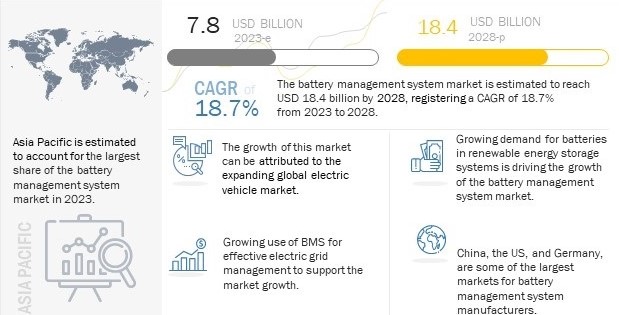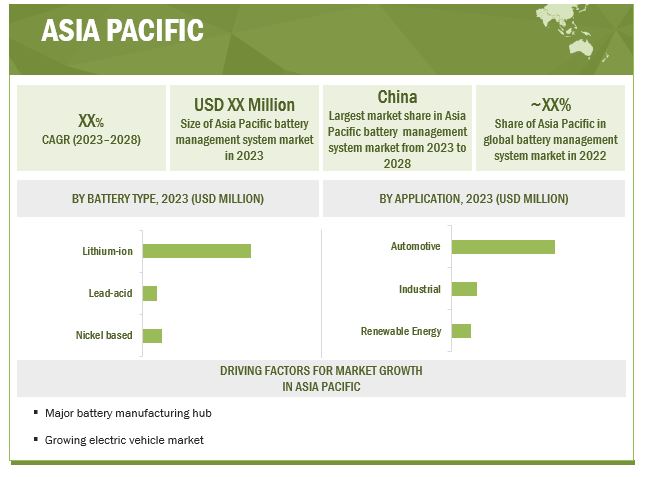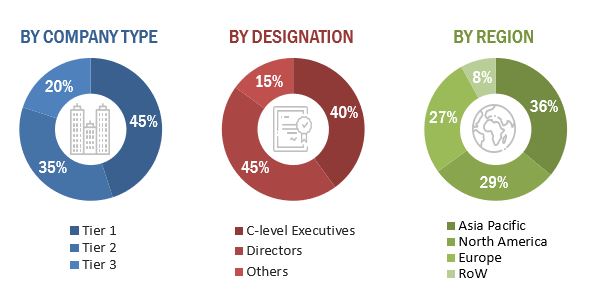Battery Management System Market Size, Share, Statistics and Industry Growth Analysis Report by Type (Motive Battery and Stationary Battery), Battery Type (Lithium-ion, Lead-acid, Nickel-based, Solid-state, Flow battery), Topology (Centralized, Distributed and Modular), Application and Region - Global Forecast to 2028
Updated on : March 03, 2023
[234 Pages Report] The Battery Management System (BMS) Market Size is expected to grow from USD 7.8 Billion in 2023 to USD 18.4 Billion by 2028, at a CAGR of 18.7% during the review period.
A battery management system is an electronic system that proficiently monitors and controls the overall operation of a rechargeable battery like lithium-ion and further ensures the optimum use of energy stored in a battery. Any BMS is a combination of both software and hardware components. The principal tasks performed by BMS include protecting the cell from damage in case of overcharging, supervising the charging and discharging process, determining the state-of-charge and state-of-health of the battery, cell balancing, prolonging battery life and performance, and monitoring temperature and voltage. The major application areas of battery management systems industry are electric vehicles, telecommunications, industrial machinery, renewable energy systems, and others.

Battery Management System Market Forecast to 2028
To know about the assumptions considered for the study, Request for Free Sample Report
Battery Management System (BMS) Market Dynamics
DRIVERS: Growing demand for efficient battery monitoring in renewable energy sector
In recent years, there has been a paradigm shift from fossil fuels toward renewable energy fuels to reduce carbon emissions and save fossil fuels from extinction. The most adopted renewable forms of energy are photovoltaic and wind energy. Although these energies are abundantly available, they are not constant and continuous sources in terms of time and output. To be able to supply the load at any point in time, storage solutions have to be adopted. Battery energy storage systems are used to store electricity and overcome the imbalance between the available energy supplied by the sources and the energy required. They offer frequency and voltage control services in case of sudden fluctuations in supply. Through battery energy storage systems, grid operators can save electricity when there is a surplus of renewable energy. Electricity can be stored in batteries and can then be distributed to cities, towns, factories, and homes when there is high demand.
RESTRAINTS: Lack of regulations related to battery management systems
The BMS has various applications, including automotive, telecommunications, renewable energy, military, and others. The BMS configurations for these applications vary and may also include customized systems according to the customer’s preference. Additionally, the BMS is classified by different topologies used in various applications. One common standard cannot serve all applications; hence, it is necessary to develop standards for the various types of BMS, topologies, and battery types. Most of the products in the market, manufactured by various companies, vary in terms of technical specifications and functions such as measuring parameters, type of estimation, communication channels, and others. Thus, finding common ground while comparing the performance of two battery management systems is perplexing.
OPPORTUNITIES: Increasing government initiatives to develop electric vehicle infrastructure
One of the major opportunities for the battery management system market is from EV charging stations. As the adoption of electric vehicles is growing both for consumer end and public transportation, setting up many e-charging stations becomes essential. Thus, the governments are helping to incentivize the number of charging stations. For instance, according to an article published by Economic Times in February 2022, EV charging stations in India have expanded by 2.5 times in megacities and are developing their charging infrastructure rapidly. Furthermore, in February 2022, the US Department of Transportation and Energy announced an allotment of USD 5 billion over 5 years to support the development of a charging station network across the country.
CHALLENGES: Fluctuations in performance due to external factors
Battery management systems are incorporated into various applications to monitor, control, and maintain the battery condition. The functions of BMS are and are not limited to determining the state of charge (SoC), state of health (SoH), the number of cycles, maintaining maximum and minimum voltage, and temperature range which require high accuracy for its effective working. The developed BMS is tested under certain conditions and environments created by the manufacturers in the development centers. After integrating the BMS with a battery-operated real-time application, there are possibilities of changed conditions, such as extreme temperatures, where the accuracy of the BMS may be affected. For instance, BMS integrated into an electric vehicle can be affected by the sudden vibration caused due to speed breakers, or the extreme temperatures caused by uncertain environments may hamper the accuracy level and performance of the BMS. Therefore, maintaining the performance level in challenging environments and under harsh external factors is a challenge for BMS systems.
Centralized topology segment is projected to grow at a significant CAGR during the forecast period.
The centralized battery management system consists of a single controller board that is directly connected to each battery pack cell. Usually, many wiring harnesses are used to route voltage levels for all cells in the battery, along with temperature sensors distributed throughout the battery. However, these battery management systems are not expansible. The centralized battery management system topology is typically economical but lacks scalability. Also, it may require a large number of wires to connect all the cells to the controller board. The centralized BMS architecture is suitable for battery packs containing a small number of cells. The centralized BMS is mainly utilized in medium-power applications such as e-bikes, portable devices, portable medical equipment, home appliances, and others. Centralized topology offers the best computational power and is the most economical topology.
Nickel-based battery segment to grow at a steady CAGR during the forecast period.
Nickel-based batteries can be found in various forms. Batteries such as nickel-metal hydride (Ni-MH), nickel-cadmium (Ni-Cd), nickel-iron (NiFe), and nickel-zinc (Ni-Zn) use nickel oxide electrodes as positive plates and are, therefore, categorized as nickel-based batteries. One of the nickel-based batteries commonly employing battery management systems for optimum functionality is the nickel-metal hydride battery. The nickel-metal battery is a high-energy-density secondary battery and uses environmentally friendly metals. It offers up to 40% higher energy density compared to nickel-cadmium batteries. The NiMH battery is replacing NiCd in markets such as wireless communications and mobile computing. BMS plays a vital role in managing the operations of the battery.
Telecommunication segment is expected to grow at an impressive CAGR during the forecast period
The telecommunications sector includes critical telecommunication infrastructure such as data centers and cell towers that deploy batteries to ensure the uninterrupted flow of electricity during a power failure. The large battery packs used for backup power for various telecommunication applications provide high energy density, but several drawbacks, such as inconsistent power, limited runtime, and high maintenance cost, are associated with these batteries. Thus, battery management systems are used to support these backup power systems to enhance efficiency and overall reliability. Besides monitoring and protecting batteries, battery management systems help deliver full power when required and prolong battery life.

Battery Management System Market Statistics by Region
To know about the assumptions considered for the study, download the pdf brochure
Asia Pacific projected to account for the largest market share in 2023.
Asia Pacific witnesses a huge demand for battery management systems from automotive applications for electric vehicles, e-bikes, and automated guided vehicles. The energy-density lithium-ion batteries are used in these applications in which dozens of cells are stacked in a series. These cells need to be managed and controlled to avoid vehicle failure, thus making the battery management system a key element in the electric vehicle architecture. A battery management system determines the battery’s usage, state of safety, and performance. It also prolongs the battery life and extends the possible range of the vehicle.
China, being a global automotive manufacturing hub, holds immense potential for the battery management system market growth. The increase in the production of vehicles and batteries used in the vehicles, is driving the Chinese market. Furthermore, China is also one of the world’s leading producers of electronic devices. This is expected to drive the Chinese market across multiple applications.
Key Market Players
Sensata Technologies, Inc. (Japan), Eberspächer (Germany), Panasonic Holdings Corporation (Japan), and LG Energy Solution, Ltd. (South Korea) are among a few top players in the Battery Management System Companies.
Battery Management System (BMS) Market Report Scope
|
Report Metric |
Details |
|
Estimated Market Size in 2023 |
USD 7.8 Billion |
|
Projected Market Size in 2028 |
USD 18.4 Billion |
|
Growth Rate |
CAGR of 18.7% |
|
Market Size Available for Years |
2019–2028 |
|
Base Year |
2022 |
|
Forecast Period |
2023–2028 |
|
Units |
Value (USD Million/USD Billion) |
|
Segments Covered |
Type, Battery Type, Topology, Application |
|
Regions Covered |
North America, Asia Pacific, Europe, and RoW |
|
Companies Covered |
Major Players: Renesas Electronics Corporation (Germany), Sensata Technologies, Inc. (Japan), Eberspacher (Germany), Analog Devices, Inc. (US), and Texas Instruments (US) and Others (Total 28 players have been covered) |
Battery Management System Market Highlights
This research report categorizes the battery management system market by type, battery type, topology, application, and region.
|
Aspect |
Details |
|
By Type: |
|
|
By Battery Type: |
|
|
By Topology: |
|
|
By Application: |
|
|
By Region |
|
Recent Developments
- In September 2022, Sensata Technologies, Inc. announced the launch of a new Battery Management System (BMS), named Lithium Balance n3-BMS, for high voltage applications.
- In June 2022, Renesas Electronics Corporation introduced an AUTOSAR-compliant complex device driver (CDD) software module for automotive battery management systems (BMS) designers for electric vehicle (EV) applications.
- In April 2022, Infineon Technologies AG introduced a new family of battery management ICs, which includes TLE9012DQU and TLE9015DQU. These ICs are optimized solutions for battery cell monitoring and balancing. In addition, they have excellent measurement performance with the highest application robustness.
Frequently Asked Questions (FAQs):
What is the total CAGR for the battery management system market from 2023 to 2028?
The global battery management system market is expected to record a CAGR of 18.7% from 2023–2028.
What are the driving factors for the battery management system market?
The expanding electric vehicle market and rising utilization of BMS in power grid applications are some of the key driving factors for the battery management system market.
Which are the significant players operating in the battery management system market?
Sensata Technologies, Inc. (Japan), Eberspächer (Germany), Panasonic Holdings Corporation (Japan), and LG Energy Solution, Ltd. (South Korea) are among a few key players in the battery management system market.
Which region will grow at a fast rate in the future?
The battery management system market in Asia Pacific is expected to grow at the highest CAGR during the forecast period.
To speak to our analyst for a discussion on the above findings, click Speak to Analyst
The study involved four major activities in estimating the current size of the battery management system market. Exhaustive secondary research has been done to collect information on the market, peer market, and parent market. The next step has been to validate these findings, assumptions, and sizing with industry experts across the value chain through primary research. Both top-down and bottom-up approaches have been employed to estimate the complete market size. After that, market breakdown and data triangulation methods have been used to estimate the market size of segments and subsegments. Two sources of information—secondary and primary—have been used to identify and collect information for an extensive technical and commercial study of the battery management system market.
Secondary Research
Secondary sources include annual reports, press releases, investor presentations of companies, white papers, certified publications, articles by recognized authors, regulatory bodies, trade directories, databases, and corporate filings such as annual reports, investor presentations, financial statements, trade, business and professional associations, white papers, manufacturing associations.
Primary Research
Primary sources are experts from the core and related industries and preferred battery management system providers, distributors, alliances, standards, and certification organizations related to various segments of this industry’s value chain.
In the primary research process, various primary sources from both supply and demand sides have been interviewed to obtain qualitative and quantitative information on the market. The primary sources from the supply side included various industry experts, such as chief experience officers (CXOs), vice presidents (VPs), and directors from business development, marketing, product development/innovation teams, and related key executives from battery management system providers, such as Renesas Electronics Corporation (Germany), Sensata Technologies, Inc. (Japan), Eberspächer (Germany), Panasonic Holdings Corporation (Japan), and Texas Instruments (US); industry associations; independent consultants and importers; distributors; and key opinion leaders.
The breakdown of primary respondents has been provided in the figure below.

To know about the assumptions considered for the study, download the pdf brochure
Market Size Estimation
Both top-down and bottom-up approaches have been used to estimate and validate the total size of the battery management system market. These methods have also been used extensively to estimate the size of various subsegments in the market. The following research methodology has been used to estimate the market size:
- Major players in the industry and markets have been identified through extensive secondary research.
- The industry’s value chain and market size (in terms of value) have been determined through primary and secondary research processes.
- All percentage shares, splits, and breakdowns have been determined using secondary sources and verified through primary sources.
Data Triangulation
After arriving at the overall market size from the estimation process explained above, the overall market has been split into several segments and subsegments. Where applicable, the market breakdown and data triangulation procedures have been employed to complete the overall market engineering process and arrive at the exact statistics for all segments and subsegments. The data has been triangulated by studying numerous factors and trends from both the demand and supply sides. The market has also been validated using both top-down and bottom-up approaches.
Report Objectives
- To define, describe, and forecast the battery management system market based on type, battery type, topology, and application
- To describe and forecast the size of the battery management system market based on four regions: North America, Europe, Asia Pacific, and the Rest of the World (RoW), along with their respective countries
- To provide detailed information regarding drivers, restraints, opportunities, and challenges influencing the market growth
- To provide a detailed overview of the process flow of the battery management system market
- To provide ecosystem analysis, case study analysis, patent analysis, technology analysis, pricing analysis, Porter’s five forces analysis, key stakeholders & buying criteria, key conferences & events, regulatory bodies, government agencies, and regulations pertaining to the market under study
- To strategically analyze micromarkets with respect to individual growth trends, prospects, and contributions to the overall market size
- To study the complete value chain of the battery management system market
- To analyze opportunities for stakeholders by identifying high-growth segments of the battery management system market
- To strategically profile the key players and comprehensively analyze their market positions in terms of their ranking and core competencies
- To analyze competitive developments, such as product launches, acquisitions, agreements, and partnerships, in the battery management system market
Available Customizations
Based on the given market data, MarketsandMarkets offers customizations in the reports according to the client’s specific requirements. The available customization options are as follows:
Company Information
- Detailed analysis and profiling of additional market players (up to 5)



 Generating Response ...
Generating Response ...







Growth opportunities and latent adjacency in Battery Management System Market